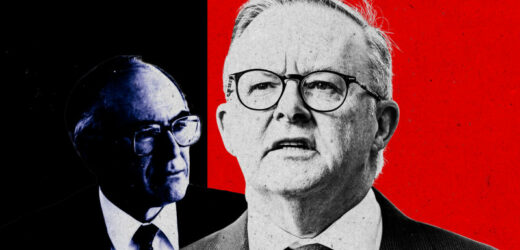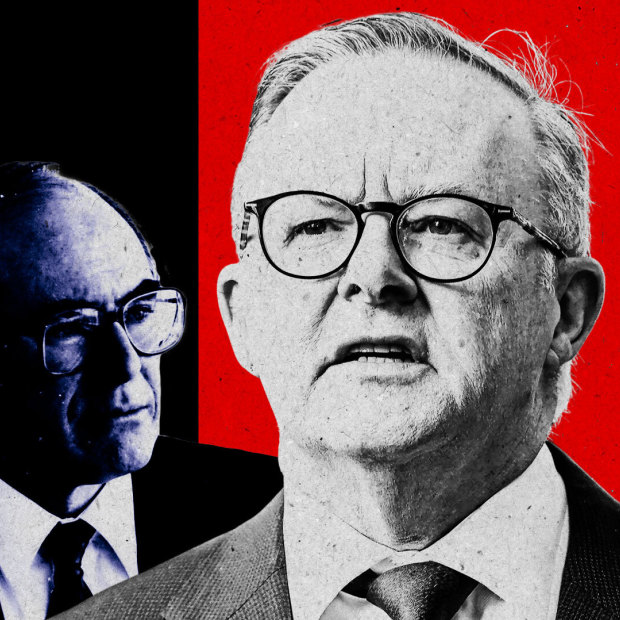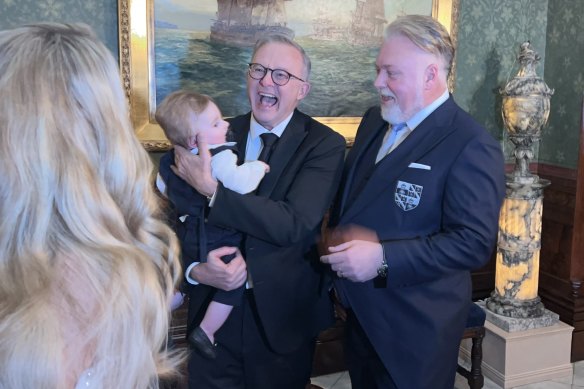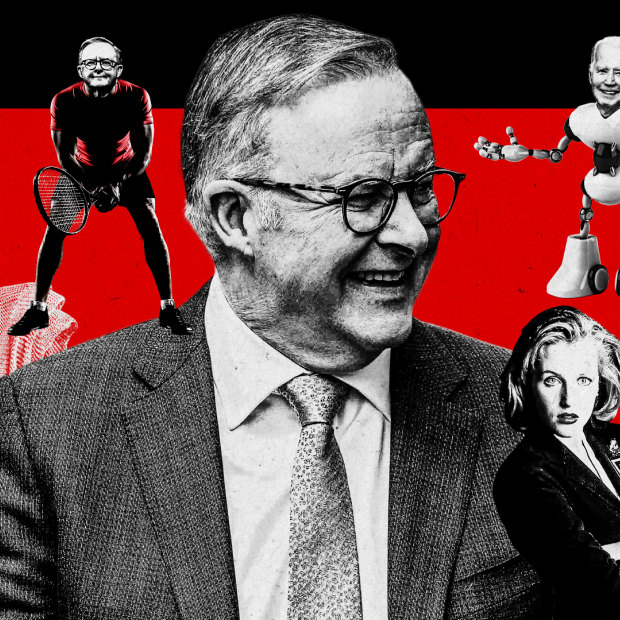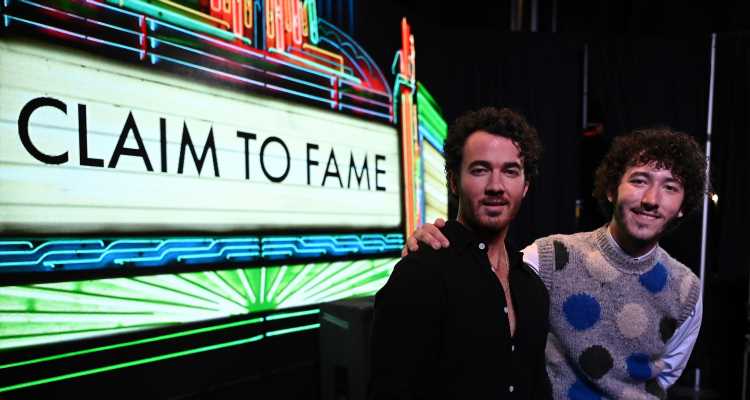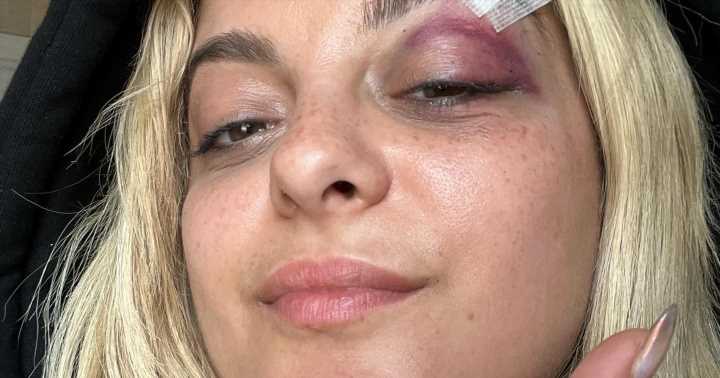By James Massola
Artwork:Credit: Marija Ercegovac
Save articles for later
Add articles to your saved list and come back to them any time.
What’s the go with aliens? Is United States President Joe Biden a robot? And why didn’t the prime minister return Erin Molan’s text messages?
Welcome to Anthony Albanese on FM radio, where the prime minister regularly reveals more about himself to the likes of 2DayFM’s Hughesy, Ed & Erin, KIIS’s Kyle & Jackie O or Fox’s Fifi, Fev & Nick than he does in “serious” radio interviews on the AM dial.
(For the record he likes X-Files but has not been briefed on Aliens, Biden is a human, and Albanese appeared again on Molan’s show soon after she complained he wasn’t responding to texts.)
A decade ago, Albanese was asked by conservative commentator Andrew Bolt why he kept appearing on the latter’s Sky News television show, even though Bolt was anathema to many in Labor.
Prime Minister Anthony Albanese with Kyle Sandilands at the radio host’s wedding this year.Credit: Twitter
“I certainly think that we’ve got to argue our case in every forum possible. That’s the approach that I have taken,” Albanese said on May 19, 2013.
An analysis by this masthead of every transcript released by Albanese’s office of his TV and radio interviews in the 12 months from May 21, 2022 – the day he was elected prime minister – makes clear the effort he makes to speak to FM radio and commercial AM radio audiences.
All told, he has held 172 press conferences and doorstops across the country and overseas, given 89 TV interviews and 128 radio interviews.
The John Howard playbook
Ben Fordham, host of Sydney radio station 2GB (owned by Nine, which also owns this masthead), says: “Albo is a Sydney boy who lived through years of John Howard dominating politics in Australia, so he has taken a leaf out of Howard’s book and then added in the FM dial.”
Albanese is the author of his own media strategy, personally maintaining relationships with key opinion makers across radio, TV and print with texts and phone calls. He’s a relationships guy.
The prime minister’s choice of whom he speaks too and when are part of a deliberate strategy to secure multiple terms in office – which this masthead’s Resolve Political Monitor polling suggests at this point in time he is on track to achieve, giving his consistently high popularity.
He has been on the high-rating breakfast TV programs Sunrise (Seven) and Today (Nine) 14 times each, and the ABC’s News Breakfast – which his predecessor Scott Morrison rarely appeared on – 11 times.
Albanese has also regularly been on the ABC’s premier current affairs show, 7.30 – another program Morrison avoided – as well as Ten’s The Project and Sky News’ First Edition, Afternoon Agenda and Sunday Agenda, though he rarely appears on the ABC’s Insiders.
So far, that’s pretty much what you’d expect.
But it’s radio, the most intimate medium, that is most revealing about Albanese’s media strategy.
In Victoria, Albanese has appeared most often on the ABC’s Melbourne Mornings with Virginia Trioli and Melbourne Drive with Raf Epstein, though he also fronts up on 3AW (owned by Nine) to speak to talkback king Neil Mitchell and chats to FM stations like KIIS and Fox.
Mitchell, who has had Albanese on his show fewer times than Trioli but who commands higher ratings, praises the PM for turning up.
“When [Queen Elizabeth] died, I texted him at 4am, thinking he would see it when he wakes up, but he replied straight away and said righto [and appeared that morning],” Mitchell says.
“There is a bit of Howard in it [Albanese’s media strategy],” Mitchell notes, in that radio allows the interviewee to go over the head of the Canberra press gallery and straight into people’s ears.
Trioli, who has hosted several ABC radio programs, agrees with Fordham that Albanese’s approach is much like Howard’s.
“Howard would show up, he was comfortable in his own skin, he could take talkback, he was well briefed, and he could range across topics. Anthony Albanese is similar in that regard,” she says.
“As this term of government goes on and things get harder, it will be interesting to see if he remains open to doing so much radio.”
Why not every state is created equal
Outside Victoria, the Albanese strategy is notably different.
In NSW, Western Australia and South Australia, Albanese appears far more regularly on commercial AM and FM radio: along with 2GB’s Fordham, he talks to Chris O’Keefe in the Drive spot, and does a swag of high-rating breakfast shows.
Albanese recently attended Kyle Sandilands’ wedding, which surprised some in Labor circles given how crude the FM shock jock can be – he recently attributed the rise in ratings to his co-host’s weight loss and promised to masturbate live on air if ratings kept going up – and has been on Hughesy, Ed & Erin (Molan, whose texts he had been ignoring) more than once.
In Queensland, Albanese spends more time in Brisbane on commercial AM and FM breakfast programs than the ABC as in most other states, but he does speak to regional Queensland ABC stations more regularly, reflecting how de-centralised the state. Those stations also broadcast into seats he’d like to win in the next election.
In WA, Albanese’s favourite radio spots are 6PR Drive (owned by Nine) with Oliver Peterson, 6PR Mornings and Nova 93.7’s Nathan, Nat & Shaun.
Peterson says Albanese began talking to him close to a decade ago, when he was opposition transport spokesman and few others bothered to appear on Perth commercial radio.
Artwork:Credit: Marija Ercegovac
“He knows without WA he wouldn’t be governing in majority in his own right, but it started out by chance,” Peterson says.
“I think he is trying to break the bias [even though] the commercial listenership is not necessarily his listenership. And he is trying to be more relatable to people with FM radio.”
Albanese has become so friendly with Nova Perth’s ex-Big Brother contestant Nathan Morris, radio announcer Nat Locke and former Fremantle Docker Shaun McManus that they flew to Canberra to have dinner with him at The Lodge earlier this week.
It was Western Australia that handed majority government to Albanese in 2022, with four seats falling to Labor in the former coalition stronghold state, and Albanese’s continued focus and appearances there are part of a deliberate strategy to ensure those seats remain in the red column after the next election.
In South Australia, commercial AM is king, with Nine-owned 5AA having him on 10 times in a year across David Penberthy and Will Goodings’ breakfast show and Leon Byner’s morning program.
The bottom line is Albanese turns up, more than once – and not just when an election is imminent, as one interviewer noted – and has carved himself a spot on top-rating shows across the country.
The FM strategy – from young listeners to footy jokes
The some-time DJ with a beer named after him and an easy-on-the-ear nickname believes FM radio reaches large numbers of people who don’t necessarily read newspapers, websites or watch the TV news – and the radio ratings bear this out.
Ten things we’ve learned about Albanese on FM radio
Breakfast on KIIS FM in Sydney has an average audience of 141,000 people and 2GB breakfast has 119,000, whereas ABC Sydney has 65,000, according to the latest GfK ratings survey.
In the Melbourne breakfast slot, 3AW has an average audience of 143,000 people, Fox FM has 70,000 and Nova FM has 49,000, while ABC Melbourne has 53,000 listeners. The numbers are similar for the morning shows.
Drilling down into the age groups, KIIS in Sydney captures 25 per cent of the radio-listening 18 to 24-year-old market and 21 per cent of 25 to 39 year olds – easily the highest. Fox and KIIS FM in Melbourne capture a combined 30 per cent of the same two age groups.
Albanese particularly likes FM radio because he gets to explain himself and be himself. To joke on Triple M Melbourne with former AFL great Billy Brownless about the 1989 grand final, or talk about power pop band You Am I with Ricki-Lee, Tim and Joel on Nova.
The PM doesn’t mind hard questions, but if you’re too aggressive, he won’t be back any time soon.
Albanese is hardly the first prime minister to spend time doing FM radio interviews – Tony Abbott and Julia Gillard were regulars too, while Morrison would do them but not issue interview transcripts, against convention.
But by spending so much time on FM radio, Albanese is cementing his identity in the minds of hundreds of thousands of people across the country.
He isn’t just focused ratings – influence counts too – and he fronts up regularly to be grilled on serious current affairs programs like 7.30 and Afternoon Agenda.
He has been on Patricia Karvelas’ RN Breakfast 11 times – more than any other show – in his first year. Although it has an average audience of about 50,000 people across the five capitals, that 7.35am interview is hugely influential with the political classes.
On Thursday, Albanese held his first press conference with the press gallery in Canberra since April 24 – an unusually long dry spell – to discuss the termination of the lease for the proposed new Russian embassy in the capital.
A broad sweep of other questions came his way, including on former Liberal staffer Brittany Higgins’ compensation pay out and the Indigenous Voice to parliament. He answered only some of them.
“Can we just ask questions about this, if that’s okay? I do lots of press conferences,” he said.
How I reported this story
The idea for this story came from Stephanie Peatling, deputy bureau chief, on a walk around the House of Representatives wing.
Compiling the piece took days and days of work, a few hours at a time, searching through Albanese’s hundreds of media appearances in his first year as prime minister and allocating them by state and by platform (the Google spreadsheet, which I colour coded and printed, was nine A3-sized pages in size 10 font. I have photos to prove it).
I then created three more spreadsheets that set out Albanese’s appearances by state, by radio station and across all platforms to drill further into the data.
The idea to talk to radio presenters Neil Mitchell, Ben Fordham and Virginia Trioli came out of a conversation I had with colleagues Matthew Knott and Lisa Visentin, while chief political correspondent David Crowe was a vital sounding board throughout the writing process.
Cut through the noise of federal politics with news, views and expert analysis from Jacqueline Maley. Subscribers can sign up to our weekly Inside Politics newsletter here.
Most Viewed in Politics
Source: Read Full Article
